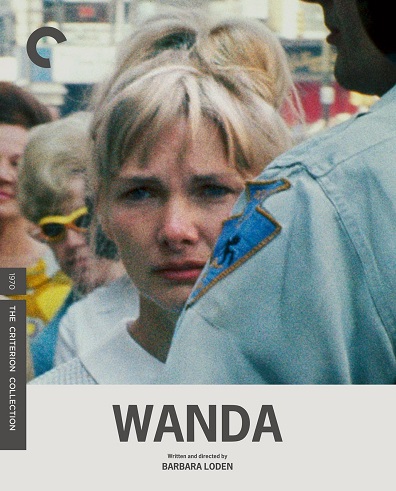
Wanda
Studio: The Criterion Collection
Mar 29, 2019
Web Exclusive
![]()
There’s a 1971 clip of Barbara Loden on the Dick Cavett Show, in which the Wanda director swats away his reductive categorization, his shorthand attempts to reduce her life story to a coal miner’s daughter up from overalls and into designer dresses. She does it again when he says her film — now regarded as a both a feminist masterpiece and landmark in American independent cinema — is about a girl who robs a bank. It’s telling that before she takes the stage that he describes her as “attractive,” before adding “determined.” Cavett wasn’t sure what to make of the actress, who wrote, directed and starred in a film with a three-person crew and infinitesimal budget.
American audiences likely weren’t ready for Wanda either, which can be seen as gritty rebuke to the glossy Hollywood films Loden appeared in and that her famed-director husband Elia Kazan directed. Celebrated in Europe as Best Foreign Film at the 1970 Venice Film Festival, it was barely seen here upon release. Wanda is now enjoying a slow-moving renaissance in U.S., reaching near critical-mass with a Criterion Collection release this month of the fully restored prints, which were given an arthouse theatre tour in 2010. 2016 saw a new biography of Loden, who died of cancer in 1980, and an article about the biography in the New Yorker, in which Richard Brody refers to her as the female counterpart to John Cassevettes. Changing feminist perspectives have also been kind to Loden’s sole directorial effort, which has aged well with modern attitudes compared to when it was released. In the early ‘70s, the film caused discomfort among many feminists because the title character is not a role model, critic Amy Taubin wrote in a recent essay.
“They could not see how the film and Loden’s performance spoke to Wanda’s humanity and to that of the majority of women worldwide who can’t envision a way to fight back,” she wrote. “In recent years, however, something has changed. And the reason can’t be simply that I now have a good DVD to show, or that Isabelle Huppert made the film her cause… The change in the attitude of young women toward Wanda preceded #MeToo, but it came out of the change that made #MeToo possible — specifically fifty years of feminist energy seeping into the culture.
“The pity is that Loden never saw how her courage in making Wanda, and the courage awakened for an instant in the character toward the end of the film, would be embraced by a generation that can see through Wanda’s eyes and understand that no one can afford the luxury of being “postfeminist.”
Wanda, of course, is not about a girl who robs a bank, as Cavett muttered. It’s about a woman with few avenues for independence and self-sufficiency. She’s ill-prepared for motherhood or domestic life, leaving her husband and children she had too young. The sewing factory boss tells her she’s too slow at work, and so she wonders indistinctly between barstools and open beds before attaching herself to a petty criminal. She stays with him because his abuse and controlling behavior is attention. He’s the first person to care about what she does or doesn’t do. “No slacks,” he yells at her, throwing them out the car window when he wants her to wear a dress. It’s a hard film to watch, emotionally. The grainy 16mm film, natural light and minimal production values add a documentary-like reality and intimacy that could encourage some viewers to look away. Aesthetically, the lo-fi production feels purposeful, integral to the message of the film, which Loden said later on was an expression of her own early life, when she molded herself as other people wanted her to be, rather than with her own agency.
She has been noted as an admirer of Godard’s Breathless, but Wanda’s bleak wandering more closely resembles another classic from the French New Wave filmmaker that she likely saw, Viva Sa Vie. Like that film’s Nana, Wanda has left her children, has no money, no job, and nothing firm to grasp onto. Both characters move and react within only immediate bounds of self-preservation, not the long-term. Any future for either of them is likely unimaginative. In Viva Sa Vie, or, My Life to Live, Nana has a conversation with a philosopher in a diner, who the tells the story of a young man who plants a bomb, but pauses and over-thinks how to put one foot in front of another just long enough to die in the explosion. Roger Ebert asked of Nana, “If she thinks, will it kill her?” For Wanda, to stop and think of the hardness of her life, or in a practical sense, to stop and over-think her means of survival, could very readily cost her a meal, shelter, or life.
Follow Ed McMenamin on twitter at @edmcmenamin
(www.criterion.com/films/29450-wanda)
Author rating: 8/10
Average reader rating: 0/10
Current Issue

Issue #72
Apr 19, 2024 Issue #72 - The ‘90s Issue with The Cardigans and Thurston Moore
Most Recent
- 10 Best Songs of the Week: Nilüfer Yanya, Linn Koch-Emmery, Fat Dog, Crumb, St. Vincent, and More (News) —
- Fat Dog Announce New Album and Tour, Share Video for New Song “Running” (News) —
- The Obsessed, Howling Giant @ Brooklyn Meadows, NYC, April 12, 2024 (Review) —
- Premiere: Slow Joy Releases New Single and Video for “King Cowboy” (News) —
- Premiere: Mackenzie Shrieve Shares New Single “Didn’t I Tell Ya” Feat. Jane Bruce (News) —

Comments
Submit your comment
There are no comments for this entry yet.